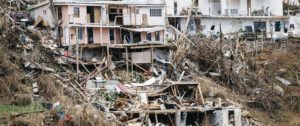
By Sunya Hassan || Contributing Writer
Hurricane Irma has left some of the most popular vacation destinations and tourism-dependent islands in ruin throughout the Caribbean. It is one of the most powerful Atlantic basin storms ever recorded.
Irma made its first landfall in Barbuda as category 5 storm on Wednesday, Sept. 6. It tore through the sixty-eight square mile island, destroying roughly ninety-five percent of the structures. The now-homeless residents of Barbuda were evacuated to the neighboring island of Antigua. According to the New York Daily News, Gaston Brown, the Prime Minister of Antigua and Barbuda stated, “It is just a total devastation. Barbuda right now is literally a rubble.” He is now faced with the challenge of rebuilding what was destroyed, which is estimated to cost over one-hundred million dollars. Yet Barbuda and Antigua were still better off compared to other islands such as St. Martin, St. Thomas, and St. John, all of which are popular tourist destinations. These places are enduring an even slower and more arduous recovery, and the U.S. Virgin Islands stated that visits to those islands should be postponed until further notice. The British Virgin Islands, sixty small territories just east of Puerto Rico, have suffered extreme damage as well. Their government, as of Monday, said that it was working to restore commercial flights, but timing as to when that would happen is still unclear.
Residents of these islands devastated by Irma still find themselves in the dark as the power remains out. There is also an increasing worry regarding the dwindling food and water supplies. Residents have been voicing feelings of abandonment, speaking up about widespread scarcity, the lack of generosity from neighbors, and even machete-armed volunteers standing guard over properties. One of the most populous British Virgin Isles, Tortola, not only fell victim to the storm but also to the looting that occurred in the aftermath.
The U.S. and European governments have supported their territories and former colonies in the aftermath. The U.S. Federal Emergency Management Agency said in a press statement that it had dispatched approximately 443,000 meals, 270,000 liters of water, and other supplies to St. Thomas and St. John. The U.S. Army Corps of Engineers is also helping by shipping a 750-kilowatt generator to St. Thomas to restart the island’s power plant. Still, many of the islanders feel overlooked. St. Thomas resident Mike Simmonds said in an interview with CNN, “One thing I can say for the weather report…whenever there’s a storm in the area, they always seem to jump over the Virgin Islands before the storm hits. It’s always, ‘Is it going to hit Florida? Is it going to North Carolina?’ I’m like, ‘Hello. It didn’t reach us yet. Tell us what to do.”
While the damage has been brutal, its full extent has yet to be determined. The situation varies from island to island and is constantly changing day by day. In some parts of the Caribbean, the storm has left thousands to fend for themselves, while in others, the tourism business continues without fault. Whatever the case may be, there is no question that the Caribbean’s recovery in the aftermath of Irma will be a long and grueling process.
First-year Sunya Hassan is a contributing writer. Her email is shassan@fandm.edu.